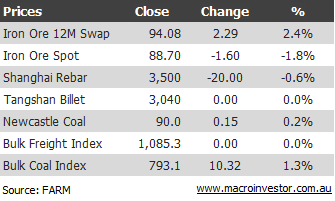Amid the dreadful iron ore coverage around the place today, there are a couple of articles worth reading. The first is from Bloomberg:
China’s iron ore output probably fell about 10 percent this month as tumbling prices squeezed out costly producers and steelmakers used cheaper imports, the China Metallurgical Mining Enterprise Association said.
Production will be about 115 million metric tons this month, little changed from July, Lei Pingxi, executive vice chairman of the association, said today in an interview in Suzhou at a Umetal conference. Output was 127.5 million tons in August last year, according to the National Bureau of Statistics.
The nation’s iron ore output had the steepest decline in July in four years, as the world’s largest metals consumer increased purchases from producers such as Brazil’s Vale SA (VALE3) and Rio Tinto Group.
So, perhaps Chinese ore rationalisation has begun at least. But a supply glut is only half of the problem. The other half is shitty demand and on that front the AFR reports on new forecasts for steel production in the decade ahead by CISA, the China Iron and Steel Association:
China’s steel-making peak body has slashed its outlook for long-term demand and forecasts the world’s second-biggest economy will need 40 per cent less steel by 2025 than estimates by Australia’s big three miners.
The downbeat forecast will put more pressure on the already battered iron ore price, and some analysts predict Chinese steel demand will fall in the next three years as the construction market remains weak.
China Iron and Steel Association deputy president Wang Xiaoqi told a forum that annual steel demand would remain at between 600 million and 700 million tonnes for the next 15 years. That compares to consensus forecasts of 1.1 billion tonnes.
CISA is not necessarily a reliable source. It is the same body that used to conduct the Chinese end of the annual contract negotiations and was roundly outfoxed by the big miners when they broke the cartel’s dominance in 2007. In short, it may carry a grudge. Nonetheless, if these forecasts are remotely correct, then the iron ore bust is going to be one for the ages.
But that’s for the long term (or not at all I hope), today the price movements are not devoid of hope:

Although spot continued its tumble, 12 month swaps enjoyed a decent bounce. This is sensible enough with swaps now pricing a not unreasonable mid $90s price twelve months out. The question now is how deep will the contango go? In the past the 12 month has generally inverted only briefly before spot rallied. But fundamental conditions right now still look dodgy, as the further falls in rebar show, so it would make quite a lot of sense for the contango to by quite deep and enduring.
The problem remains that with such an immature futures market, price discovery is very dependent upon real physical demand so the 12m may fold again too. We shall see.

